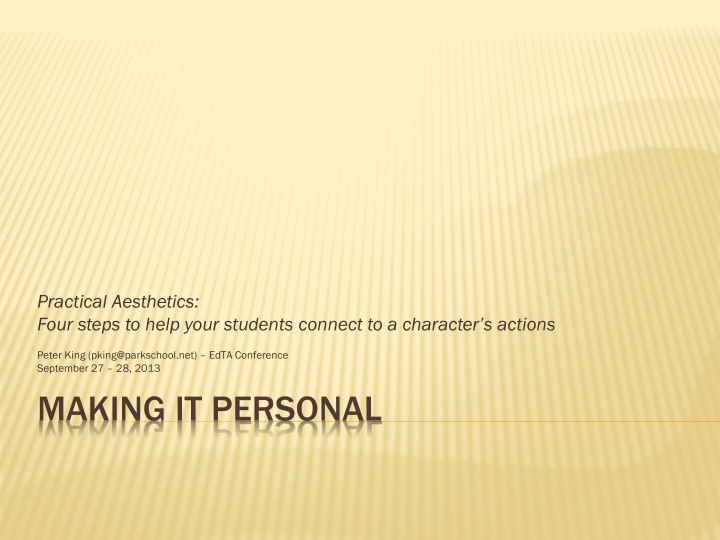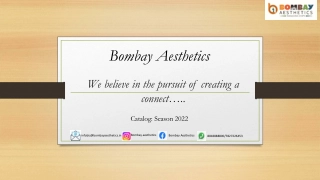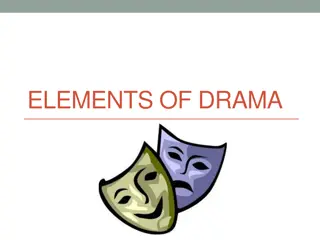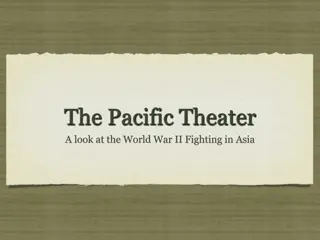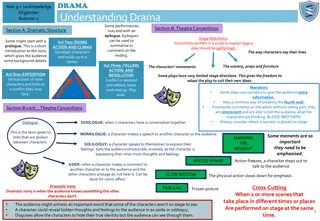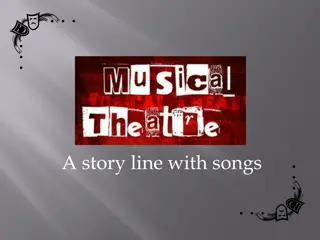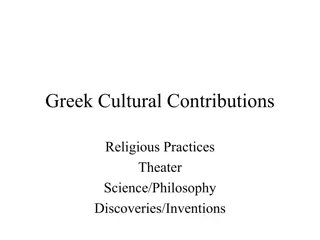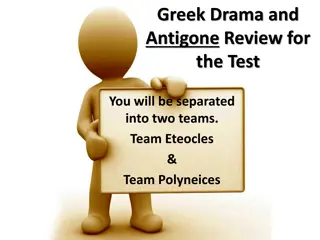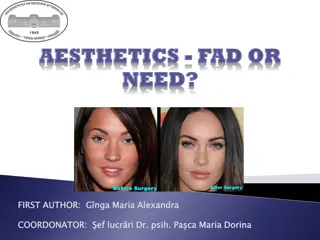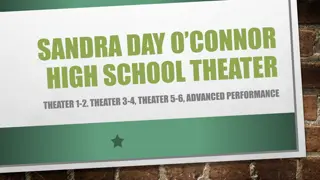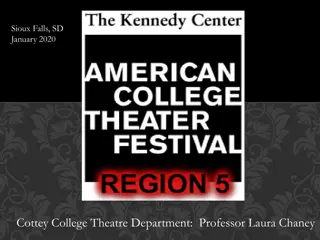Practical Aesthetics in Teaching Theater: Four Steps to Connect Students with Characters
Explore Practical Aesthetics to help students engage with characters through four essential steps: understanding the character's literal actions, desires, essential actions, and personal connection. Learn how to personalize acting work and empower students to delve deeper into their roles.
Download Presentation

Please find below an Image/Link to download the presentation.
The content on the website is provided AS IS for your information and personal use only. It may not be sold, licensed, or shared on other websites without obtaining consent from the author.If you encounter any issues during the download, it is possible that the publisher has removed the file from their server.
You are allowed to download the files provided on this website for personal or commercial use, subject to the condition that they are used lawfully. All files are the property of their respective owners.
The content on the website is provided AS IS for your information and personal use only. It may not be sold, licensed, or shared on other websites without obtaining consent from the author.
E N D
Presentation Transcript
Practical Aesthetics: Four steps to help your students connect to a character s actions Peter King (pking@parkschool.net) EdTA Conference September 27 28, 2013 MAKING IT PERSONAL
Warm-up Introductions Goals Background Practical Aesthetics The Four Steps Share Recap and Questions MAKING IT PERSONAL
GOALS Learn the background of the technique known as Practical Aesthetics Form a working knowledge of Practical Aesthetics (The Four Steps) Know the importance of personalizing work Feel empowered to dig deeper with your students
BACKGROUND Practical Aesthetics: a rehearsal technique David Mamet, William H. Macy, Gregory Mosher Based on Stanislavsky s and Sanford Meisner s work A Practical Handbook for the Actor, Lee Michael Cohn The Atlantic Acting School My own idiosyncratic evolution Article: Making It Personal in the journal, Teaching Theater
1. What is the character literally 2. What does the character want 3. What is my essential action 4. What is the action like to me? It s as if literally doing? want in the scene? action? as if THE FOUR STEPS
1. What is the character literally 2. What does the character want 3. What is my essential action 4. What is the action like to me? It s as if literally doing? want in the scene? action? L Lords W Wear A Ancient A Apparel as if THE FOUR STEPS
STEP ONE: The characters literal literal activity The Popcorn Test
A QUICK EXAMPLE (Ben and Georgi are brother and sister.) (Ben and Georgi are brother and sister.) BEN BEN: I won t ask you again. GEORGI GEORGI: I don t believe you. BEN BEN: I wouldn t ask you unless I really needed it. GEORGI GEORGI: What you really need is help, Ben. BEN BEN: Please. 300 bucks, that s it. GEORGI GEORGI: I won t. I can t.
A QUICK EXAMPLE: STEP ONE 1. The scene s literal asking his sister for money. literal activity: Ben is literally
STEP ONE: The characters literal literal activity A non-interpretive, non-judgmental statement about what s going on in the scene. Includes everything that happens in the scene or unit of action in a single descriptive clause. Includes what the character says (the script). Includes stage business. What we say say versus what we mean mean.
STEP TWO: The characters want want Within the literal confines of the scene, what specifically does your character want The test test will be in the other character. Will have a clear cap cap (a visual or verbal sign the character has gotten what she wants). Should be as concrete and as physical as possible. want?
A QUICK EXAMPLE (Ben and Georgi are brother and sister.) (Ben and Georgi are brother and sister.) BEN BEN: I won t ask you again. GEORGI GEORGI: I don t believe you. BEN BEN: I wouldn t ask you unless I really needed it. GEORGI GEORGI: What you really need is help, Ben. BEN BEN: Please. 300 bucks, that s it. GEORGI GEORGI: I won t. I can t.
A QUICK EXAMPLE: STEP TWO 1. The scene s literal asking his sister for money. 2. The want want: Ben wants his sister to give him three hundred bucks. literal activity: Ben is literally
STEP TWO: The characters want want Within the literal confines of the scene, what specifically does your character want The test test will be in the other character. Will have a clear cap cap (a visual or verbal sign the character has gotten what she wants). Should be as concrete and as physical as possible. want?
STEP THREE: My action action Essential Action: the physical pursuit of a specific goal goal with a partner on stage. Text vs. Subtext Improvisations
A QUICK EXAMPLE (Ben and Georgi are brother and sister.) (Ben and Georgi are brother and sister.) BEN BEN: I won t ask you again. GEORGI GEORGI: I don t believe you. BEN BEN: I wouldn t ask you unless I really needed it. GEORGI GEORGI: What you really need is help, Ben. BEN BEN: Please. 300 bucks, that s it. GEORGI GEORGI: I won t. I can t.
A QUICK EXAMPLE: STEP THREE 1. The scene s literal asking his sister for money. 2. The want want: Ben wants his sister to give him three hundred bucks. 3. The essential action action: get someone to help me out of a bind. literal activity: Ben is literally
STEP THREE: My action action Essential Action: the physical pursuit of a specific goal goal with a partner on stage. Is an intersection between the character s wants and your own. Has a test test in the partner and a cap Phrased in a way that you can attach your as-if cap.
SAMPLE ACTIONS get a friend to divulge a secret boost someone s self-confidence gain a friend's trust urge a friend to take a big chance gain a sibling s sympathy beg for a friend's help force a friend to face his problems lead a friend astray console a lost sheep get someone to respect my beliefs seek a potential ally's support get a someone to respect my boundaries get jerk off my back make a special person accept a change in our relationship get a loved one to take care of me get a sibling to empathize with me get a friend to lighten up encourage a child to be self-reliant seek a friend's advice buy someone's silence get a lover to share my dream get a bud to give me a break force someone to see the errors of her ways get a friend to grow up get a loved one to let me go get someone to admit his or her guilt force a stranger to apologize get a co-worker to do my bidding steer a friend away from the truth
Action + Obstacle = Conflict Conflict = Drama (desire plus danger equals drama) THE DRAMATIC EQUATION
Action + Obstacle = Conflict Conflict = Drama (desire plus danger equals drama) THE DRAMATIC EQUATION
STEP FOUR: The as as- -if if What does the action mean It s as-if mean to you personally personally?
A QUICK EXAMPLE (Ben and Georgi are brother and sister.) (Ben and Georgi are brother and sister.) BEN BEN: I won t ask you again. GEORGI GEORGI: I don t believe you. BEN BEN: I wouldn t ask you unless I really needed it. GEORGI GEORGI: What you really need is help, Ben. BEN BEN: Please. 300 bucks, that s it. GEORGI GEORGI: I won t. I can t.
A QUICK EXAMPLE: STEP FOUR 1. The scene s literal asking his sister for money. 2. The want want: Ben wants his sister to give him three hundred bucks. 3. The essential action action: get someone to help me out of a bind. 4. The as as- -if if: It s as if I m trying to get my wife, who works, to stay home with our sick kid, so I can go to rehearsal. literal activity: Ben is literally
STEP FOUR: The as as- -if if What does the action mean Something you would love Same action action as the character s, not the same situation situation. Is a current current and unresolved action in your life. May have imaginary imaginary circumstances, but the target must be a real person in your life. mean to you personally love to do or must personally? must do.
Improvised As-If Scenes SHARE
RECAP Why making it personal is so important A working knowledge of The Four Steps of Practical Aesthetics A newfound power to dig deeper with your students, to help them connect their personal lives to their art.
David Mamet ALWAYS TELL THE TRUTH. IT S THE EASIEST THING TO REMEMBER
